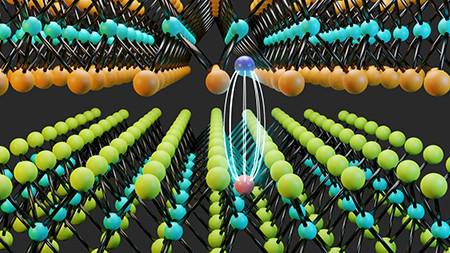The European Physical Journal B ( IF 1.6 ) Pub Date : 2020-12-02 , DOI: 10.1140/epjb/e2020-10490-9 Maurício F. C. Martins Quintela , Nuno M. R. Peres

|
Abstract
In this colloquium, we review the research on excitons in van der Waals heterostructures from the point of view of variational calculations. We first make a presentation of the current and past literature, followed by a discussion on the connections between experimental and theoretical results. In particular, we focus our review of the literature on the absorption spectrum and polarizability, as well as the Stark shift and the dissociation rate. Afterwards, we begin the discussion of the use of variational methods in the study of excitons. We initially model the electron–hole interaction as a soft-Coulomb potential, which can be used to describe interlayer excitons. Using an ansatz, based on the solution for the two-dimensional quantum harmonic oscillator, we study the Rytova–Keldysh potential, which is appropriate to describe intralayer excitons in two-dimensional (2D) materials. These variational energies are then recalculated with a different ansatz, based on the exact wavefunction of the 2D hydrogen atom, and the obtained energy curves are compared. Afterwards, we discuss the Wannier–Mott exciton model, reviewing it briefly before focusing on an application of this model to obtain both the exciton absorption spectrum and the binding energies for certain values of the physical parameters of the materials. Finally, we briefly discuss an approximation of the electron–hole interaction in interlayer excitons as an harmonic potential and the comparison of the obtained results with the existing values from both first-principles calculations and experimental measurements.
Graphical abstract
中文翻译:

应用于二维材料激子的变分方法座谈会
摘要
在本次座谈会上,我们将从变分计算的角度回顾了范德华异质结构中激子的研究。我们首先介绍当前和过去的文献,然后讨论实验和理论结果之间的联系。特别地,我们将文献综述集中在吸收光谱和极化率,斯塔克位移和解离速率上。之后,我们开始讨论在激子研究中使用变分方法。我们最初将电子-空穴相互作用建模为软库仑势,可用于描述层间激子。使用ansatz,基于二维量子谐振子的解决方案,我们研究了Rytova–Keldysh势,该势适于描述二维(2D)材料中的层内激子。然后使用不同的ansatz重新计算这些变分能量根据二维氢原子的精确波函数,比较了获得的能量曲线。此后,我们讨论了Wannier-Mott激子模型,并在对其进行重点介绍之前简要回顾了该模型,以便获得材料物理参数某些值的激子吸收光谱和结合能。最后,我们简要讨论层间激子中电子-空穴相互作用的近似为谐波势,以及将所得结果与第一性原理计算和实验测量中的现有值进行比较。



























 京公网安备 11010802027423号
京公网安备 11010802027423号